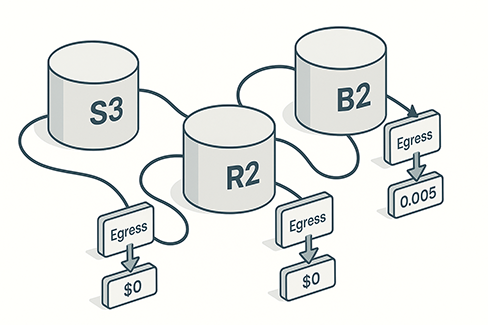What is Shared Hosting and when to choose it for your MVP

Shared hosting is the most common starting point for new websites and applications. In this model, multiple websites share the same physical server and its resources, including CPU, memory, and storage. It is designed for simplicity, offering affordable pricing and pre-configured environments that can get you online quickly.
For a SaaS MVP (Minimum Viable Product), shared hosting can be a reasonable initial choice if your primary goal is to validate the concept without committing large upfront costs. Non-technical founders, in particular, may appreciate the low learning curve and bundled support.
Shared hosting advantages for early-stage startups
- Cost efficiency: Plans often start as low as $3 per month, making it one of the cheapest ways to host a web application.
- Simplicity: Providers usually include control panels (e.g., cPanel, Plesk) with one-click installations for frameworks, databases, and SSL certificates.
- Support included: Technical assistance is generally bundled, which saves time for founders unfamiliar with server management.
- Quick deployment: Setting up hosting takes minutes, allowing teams to focus on building and testing their SaaS features instead of infrastructure.
Example: A founder testing a lightweight SaaS tool (like a calendar integration or single-function productivity app) may run their prototype on shared hosting for under $10/month while attracting the first 50–100 beta users.
Technical limitations and scalability constraints
While shared hosting is budget-friendly, it comes with clear limitations:
- Limited performance: Resource caps mean your app can slow down significantly if another site on the same server consumes excessive CPU or memory.
- Restricted customization: Root access is not provided. You cannot tweak low-level configurations, install custom software, or optimize performance deeply.
- Scalability bottlenecks: Shared hosting is not designed to handle high traffic or complex workloads. A SaaS app experiencing even moderate success will quickly outgrow it.
- Security concerns: Since multiple websites coexist on the same server, a vulnerability in one site can potentially affect others.
In practice, shared hosting works for proof-of-concept stages but is rarely suitable beyond the earliest MVP testing phase.
Cloud VPS explained: full control for your SaaS
A Cloud VPS (Virtual Private Server) is a step up from shared hosting, giving you isolated virtualized resources within a larger cloud infrastructure. This means you have guaranteed CPU, RAM, and storage allocations that are not affected by other tenants.
For SaaS MVPs aiming at real-world users beyond an initial test group, a Cloud VPS provides the reliability, flexibility, and control necessary to scale.
Key differences vs shared hosting infrastructure
- Dedicated resources: Performance is consistent because you are not competing with other websites.
- Full control: With root access, you can install custom software stacks, configure firewalls, and optimize databases for your SaaS needs.
- Cloud scalability: Most providers let you scale vertically (upgrade CPU/RAM) or horizontally (add more servers) within minutes.
- Enhanced security: Isolation reduces cross-tenant risks common in shared environments.
Example: A SaaS MVP handling user logins, dashboards, and API integrations would benefit from the resource guarantees of a VPS to ensure uptime and performance.
VPS types: managed vs unmanaged trade-offs
- Managed VPS: The provider handles server updates, patches, and basic monitoring. Ideal for non-technical founders or lean teams. Pricing usually starts at $20/month.
- Unmanaged VPS: Full control with lower costs ($5–10/month) but requires technical expertise in Linux administration, security hardening, and performance tuning.
The choice depends on your team’s skill set. A non-technical founder may prefer managed VPS despite the higher cost, while technical teams can leverage unmanaged VPS for budget efficiency.
Direct cost comparison: real expenses in year one
Shared hosting: $3-15/month breakdown
- Entry-level plans: Around $3–5/month, typically offering limited storage (10–20GB) and restricted bandwidth.
- Mid-tier plans: $8–12/month, often include SSL certificates, domain credits, and more generous bandwidth.
- Premium shared hosting: $12–15/month with performance enhancements (e.g., caching layers, better support).
Total annual cost: $36–$180. Suitable for proof-of-concept SaaS MVPs with minimal traffic.
Cloud VPS: $5-50/month cost analysis
- Unmanaged VPS: $5–10/month for basic setups with 1–2GB RAM.
- Balanced VPS: $15–30/month, sufficient for early SaaS platforms serving hundreds of users.
- Managed VPS: $25–50/month, with professional support and monitoring.
Total annual cost: $60–$600. Higher than shared hosting, but with vastly improved performance and flexibility.
Performance and scalability: what to expect from each
Shared hosting offers limited performance consistency. Resource spikes from other tenants can slow down your SaaS unexpectedly. Scaling options are minimal; upgrading usually means switching to VPS or dedicated hosting.
Cloud VPS, by contrast, provides stable and predictable performance. You can scale resources quickly as user demand increases, making it ideal for SaaS MVPs expecting growth. With caching layers, load balancing, and database optimizations, VPS environments can handle sudden traffic surges without downtime.
Specific use cases for SaaS MVPs

Basic e-commerce vs complex platform requirements
- Basic SaaS or e-commerce MVPs (like a Shopify clone or niche subscription service) may function on shared hosting if traffic is low.
- Complex SaaS platforms (with multi-user dashboards, analytics engines, or API integrations) demand the dedicated resources of a VPS from the outset.
Expected traffic patterns and load spikes
If your MVP targets small user groups or closed beta testing, shared hosting suffices. However, if you expect viral sign-ups, demo day exposure, or investor showcases, a VPS ensures the infrastructure won’t fail at critical moments.
Migration strategy: when and how to move from shared to VPS
Signs it’s time to migrate:
- Page load times exceed 3 seconds.
- You see “resource limit exceeded” warnings.
- Security or compliance requirements grow (e.g., handling payment data).
- Beta testing shows user numbers outpacing shared hosting capacity.
Migration is typically straightforward: providers offer automated transfer tools, or you can hire freelancers to handle it in a few hours. Planning migration before scale-up events (e.g., product launch or marketing campaigns) prevents downtime.
Recommended providers by category and budget
- Shared hosting: Bluehost, HostGator, SiteGround.
- Cloud VPS (unmanaged): DigitalOcean, Vultr, Linode.
- Cloud VPS (managed): Cloudways, ScalaHosting, InMotion.
Choose based on your technical comfort and expected MVP lifespan.
Decision checklist for technical and non-technical founders
- Budget under $20/month? → Start with shared hosting.
- Expecting more than 500 active users in first months? → Go VPS.
- Non-technical founder without dev support? → Choose managed VPS.
- Technical team ready to optimize? → Save costs with unmanaged VPS.
The hosting choice is not permanent. Start lean, then upgrade as your SaaS demonstrates traction.
For SaaS MVPs, hosting is a balancing act between cost, simplicity, and scalability. Shared hosting works for idea validation and micro-tests, but Cloud VPS offers the control, reliability, and performance needed to serve real users. Founders should consider budget, expected traffic, and technical skills when deciding. A planned migration path ensures you can scale smoothly as your SaaS gains traction.
FAQs
Is shared hosting secure enough for SaaS?
For prototypes, yes, but for production SaaS apps handling user data, VPS with better isolation is safer.
Can I upgrade directly from shared hosting to VPS?
Yes. Most providers have migration tools that simplify the process.
What if I have no technical skills?
Choose a managed VPS provider to handle server operations while you focus on product development.


